This weekend at FTM10 (Feminist Theory and Music conference) at University of North Carolina in Greensboro, I witnessed "taut", a collaboration conceived and performed by Tomie Hahn and sculptor Melanie Klein. Tomie and Melanie wore rockclimbing harnesses and supported the weight of each other using bike tires bound together by industrial-strength rubber bands. Tomie played the shakuhachi while the two women swayed and held in tension: articulating togetherness, strength, and presentness through sound, sight, and embodiment.
Program notes:
keep the line
betwee us
well traveled
xxxxxxxxbuzzing
xxxxxxxxxxrattling
It was an elegant, in-tense performance. I look forward to seeing future collaboration between Tomie and Melanie.
I also had the honor of performing with Tomie in a free improv set with my improv trio Pinko Communoids. Media and report of this show will soon to be posted.
5.31.2009
taut: Tomie Hahn and Melanie Klein Held In-Tense
Posted by
wh
at
6:48 PM
4
comments
![]()
Labels: FTM, Greensboro, pictures
5.27.2009
Press Release: APAture: Call for Artist Submissions
Kearny Street Workshop, the oldest Asian Pacific American multidisciplinary organization in the United States, is now accepting submissions for the 11th annual APAture festival of emerging Asian American artists. Each September, APAture showcases about 100 artists at venues throughout San Francisco, making it the Bay Area's biggest platform for Asian American art.
We are accepting submissions in five disciplines: visual arts, film & video, music, literary arts and performing arts. The deadline to submit is July 11, 2009.
Go to kearnystreet.org/apature for more info and to apply online!
Questions? Contact apature@kearnystreet.org
Posted by
wh
at
5:56 PM
1 comments
![]()
Labels: upcoming events
Afterquake Gives Voice to the Victims of Sichuan Earthquake
Afterquake is a musical collaboration led by Abigail Washburn and David Liang of the Shanghai Restoration Project, in cooperation with Sichuan Quake Relief. Washburn conceived of the project while performing American old time music in Sichuan after the devastating earthquake struck on May 12, 2008. She encountered children who were eager to share their songs with her during her performance trips. Together on a two-week trip in March 2009, they traveled to sites of earthquake destruction to record the music and ambient sounds of Wenchuan County in the Sichuan Province. Liang and Washuburn then joined forces to "remix voices and sounds from the China earthquake zone" with an aim "to raise awareness for victims still in need."
Release on May 12, 2009, a year after the event, the Afterquake EP contains 7 tracks of electronica collages of field recordings artfully recombined. I especially recommend "Song for Mama". Narrating the separation between youngster Chen Honglin and his family, this track features Chen's heart wrenching vocal performance, his mother's spoken lines, over a foundation rhythmically supported by the environmental sounds representing his family's arduous work behind reconstructing their home. The entire track can be previewed as a slide show on the site.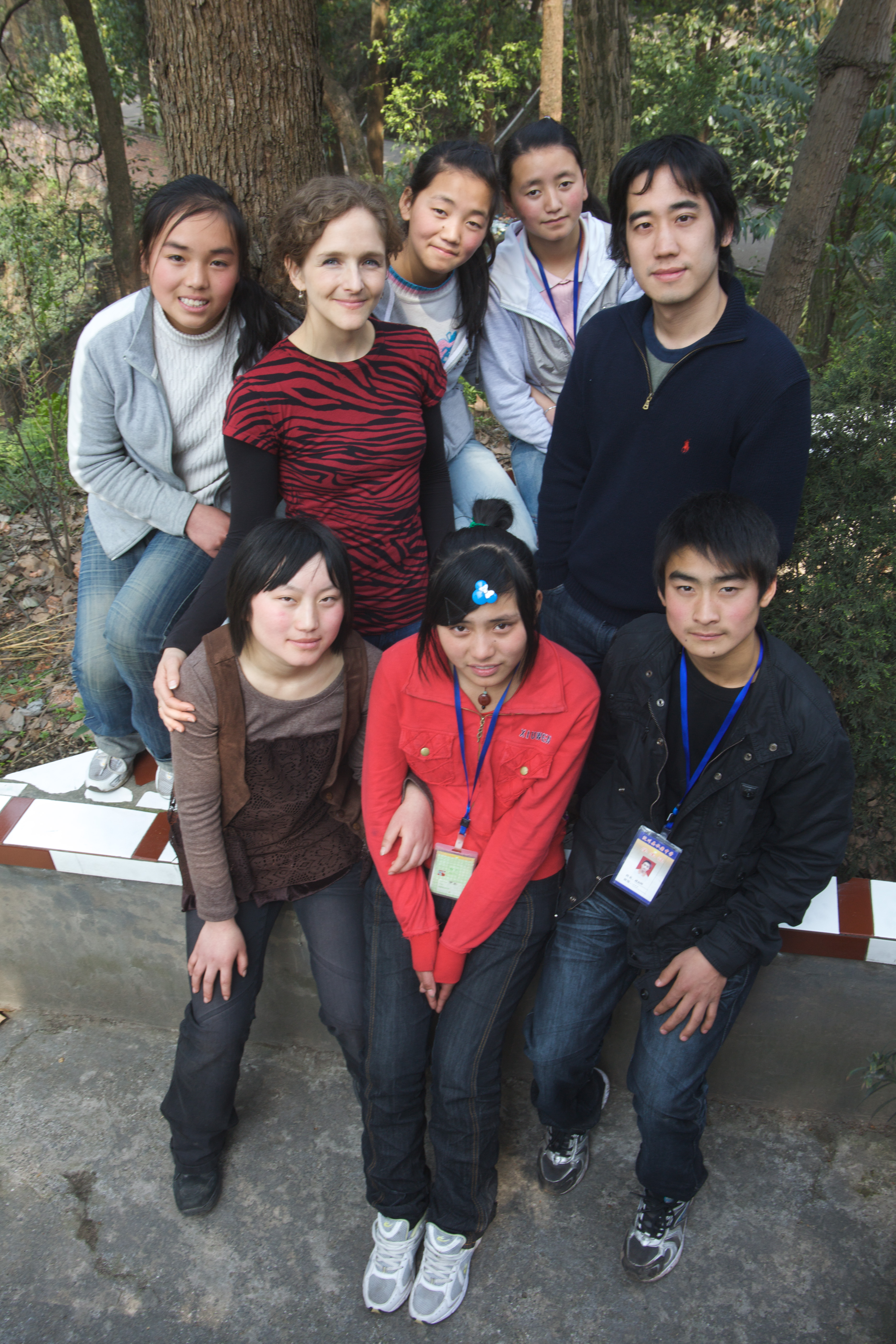
Washburn, Liang, and the children (left front, Chen Honglin)
In particular, the ethnographic aspects of the project impress the ethnomusicologist in me. Afterquake's ethics of representing the local participants departs from various cross-cultural collaborations under the genre label of "World Beat" or "World Music" (Micky Hart, Paul Simon, Peter Gabriel, etc). The project's multimedia website contextualizes the sources of the music in a descriptive narrative. Field recordings, credits, and interview transcripts of the local participants involved in the making of each of the tracks are posted on the page to help the listener imagine the process of creation. Liang and Washburn carefully documented their collecting and remxing processes, evidenced by their "The Making Of" and "Interview" videos and photo gallery on the website.
The Afterquake album can be purchased from various China, Taiwan, and US-based MP3 vendors making the tracks available to an international audience. Audiophiles and humanitarian enthusiasts can purchase the special physical editions of the album with artwork from the Afterquake online store directly to benefit Sichuan Quake Relief, boosting their efforts "to provide much needed resources to individuals, schools and communities recovering from the earthquake."
Posted by
wh
at
7:55 AM
0
comments
![]()
Labels: china, collaboration, current events, media, transnational
5.26.2009
Press Release: Asian Rock Fest 5.30.09
Eric Hsu of Johnny Hi-Fi has been busily organizing for the 2009 Asian Rock Fest. The event will take place 7pm this Saturday, May 30, 2009, at Slim's in San Francisco. It will feature performances by Johnny Hi-Fi, Burning Tree Project, United High, and Festizio.
This festival started in New York City in 2004 highlighting Asian and Asian American musical talent. The ARF website states its objective as "to celebrate the annual Asian Heritage Month of May in an in-your-face, louder than your parents' soft jazz fashion. Put down the text books and scream f#@k the stereotypes. THIS is how Asians rock!"
Johnny Hi-Fi (Hsu and drummer Asif Khan) is also behind Passion and Profession, a non-profit organization that brings workshops on issues related to career choice and bicultural upbringing to college campuses. YellowBuzz attended a Passion and Profession workshop at Mount St. Mary's University in Maryland last September and witnessed its infectious energy and earnest connections with students. Impressed by it, I am working on bringing Eric and Asif to University of Virginia, where I teach, hopefully for next spring.
Johnny Hi-Fi has recently released their album Vicious Cycle of Promises & Apologies. It's available as a free download on JHF's official band bsite.
Posted by
wh
at
7:19 PM
0
comments
![]()
Labels: San Francisco, upcoming events
5.25.2009
Press Release: Pinko Communoids + Tomie Hahn
I will be performing with my trio Pinko Communoids in Greensboro, NC twice this week. Our first show (5.28) is a collaboration with Tomie Hahn, an incredible shakuhachi and movement improviser, also the author of Sensational Knowledge. Our second show will be at the Feminist Theory & Music 10 (FTM 10) meeting at UNC-Greensboro: 8pm, Saturday 5/30, Recital Hall.
Come check out our performance if you just so happen to be in Greensboro! See the poster for details.
Posted by
wh
at
8:23 PM
0
comments
![]()
Labels: upcoming events
5.24.2009
Pics: The Kominas @ Nick's Basement
Finally, I got around to posting the pictures I took at the Kominas' recent show at Nick's Basement in Lowell, MA on 5/15/09. As the night went on, the basement got darker and darker, making photography more challenging. There are also pictures from some of the other sets of the night.
These are my favorite shots:
Basim Usmani
Karna Ray (he's there, trust me)
Shahjehan Khan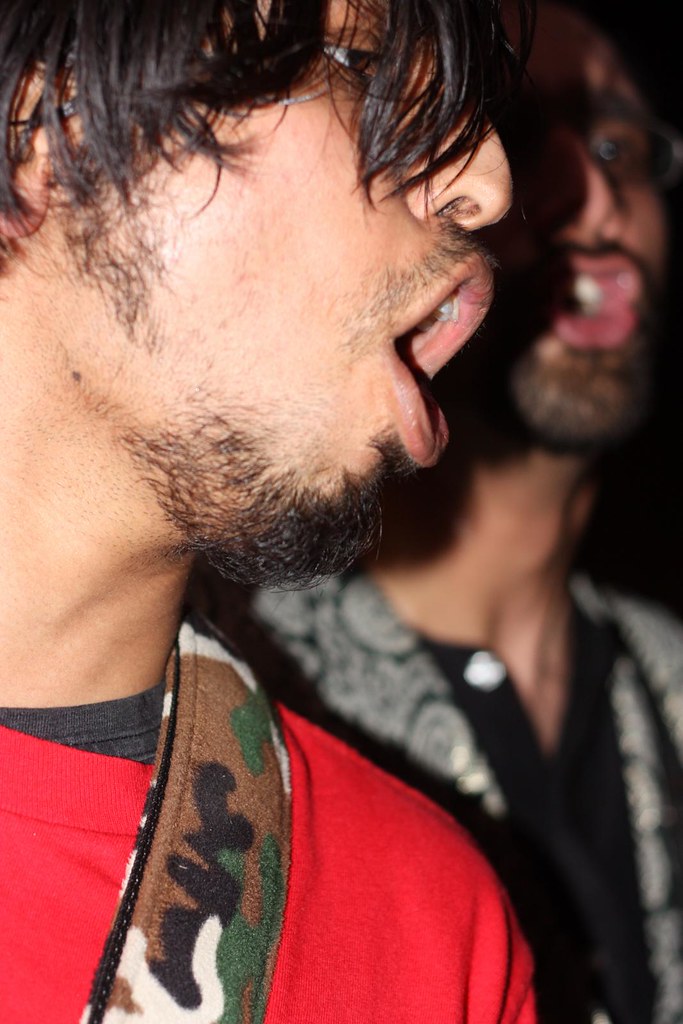
Arjun Ray (and Shahj)
Basim
More pictures from this set.
Posted by
wh
at
2:21 PM
0
comments
![]()
Labels: Boston, field notes, pictures, taqwacore
Press Release: Kollaboration 6.27.09
Kollaboration New York will showcase Asian American talent on June 27, 2009 at the NYU Skirball Center. Here's a promotion video featuring Ne-Yo's song "Closer".
Press Release:
As Kollaboration New York gets closer to the show on June 27th, 2009, one thing is certain. New York is the place for dreamers. Among its stoops, skyscrapers, and subway stations, there is an unmistakable undercurrent of dreams realized, not quite realized, taking shape. Getting closer.
In our pursuit of helping realize dreams, KNY has been blessed to receive the moral and artistic support of the New York music and entertainment community. A few local artists (not necessarily competitors) spent weeks to help put together this video in celebration of our mission. This project is a collaboration in the truest sense of the word. An homage to New York City, its dreamers, the pursuit of dreams...
To getting closer.
In the meantime, tremendous thanks to our community of artists:
Alfa Garcia
Andrew Kim (SiC)
Derek Kan
G*LEE
Marie Yoon Choi
Mark Choi (SiC)
Melissa 'Pisa' Tinana
Taiyo Na
Theresa Vu
Tim Rhee (SiC)
Vudoo Soul
And to the crew:
Mike Galvan - Executive Producer
Jinny Jung
Grace Audrey Kim
Kym Pham - Producer
Davidian Shaw - Director / Producer
Charles Wang
Nanah Yun
This video was made possible by Cinemascope Films // http://www.cinemascopefilms.
Posted by
wh
at
12:58 PM
0
comments
![]()
Labels: new york, upcoming events, video
5.22.2009
Playlist of Al Jazeera English on Taqwacore
Playlist, a series of video/textual programming on music hosted by Al Jazeera English, just released an episode on the taqwacore phenomenon, or as the show labels it, "the taqwacore movement." The 10-minute video highlights quotes from Mike Knight and Marwan Kamel, a Syrian-American who fronts the Chicago-based Al Thawra. It also contains footage from the taqwacore band tour in 2007 and their intervention at the ISNA conference.
QTV Interviews Mike Knight and Omar Majeed on "Taqwacore"
Only posted a week ago, this video features an interview of Mike Knight, the author of The Taqwacores, and Omar Majeed, the maker of a documentary film based on the lives of the taqwacore bands.
Knight and Majeed offer an insight on the state of taqwacore in reality and in principles. They talk about their personal experiences of soul-searching in pre- and post-911 as Muslim youth, wanting to find an "alternative Muslim voice." Their take-home message, I think, is that taqwacore is not a social movement. Instead it is a safe environment in which Muslims of diverse relationships to Islam can be themselves with personal and social integrity, a healthy context to reconcile differences such as rock music and Muslim parents. A couple of memorable quotes from the interview:
Mike Knight: “I realized that I’d rather be inside the mosque urinating out than to be outside the mosque urinating in.”
Omar Majeed: “There's a lot of attention on how should Islam be defined. Maybe the point is to undefined it.”
This 18-minute interview video is worth watching in its entirety. I'd be curious to know what individuals associated with the taqwacore label think about it.
5.21.2009
The Kominas Shake Musical and Social Grounds: Thoughts on Wild Nights in Guantanamo Bay

The Kominas have shaken musical and social grounds since 2005. They are not exactly hardcore. They are definitely not straightedge. They are not even “Taqwacore” in any definitive ways, apparently. Originally conceived in Michael Muhammad Knight’s novel The Taqwacores, the term “Taqwacore” represents the intersection of the Islamic faith and punk, taking the Arabic word “taqwa” meaning “piety.” What seems certain is that this Boston-based group vocalizes anthems that challenge the agendas of conservative Muslim Americans and rev against the ethnocentric pigeonholing and racialization of South Asians in the post-9/11 United States and the world at large. Or maybe their music is not intended to be as anthemic as it has been construed by mainstream media.
On my recent trip New England last week, I interviewed the guys in the Kominas at South Street Diner near Boston South Station. The band recounted their experiences with press outlets including MTVdesi, CNN, The Rolling Stone, and Newsweek, while telling stories about their 2007 tour and the social eruption at the ISNA (Islamic Society of North America) meeting. Our conversation led me to see an uneasy dissonance between the hypermedia--surrounding the band’s Taqwacore or “Muslim punk” identity--and the striking lack of attention on the actual sounds and meanings of their music. So I decided to offer a few thoughts on the Kominas’ 2008 album Wild Nights in Guantanamo Bay.
The Kominas infuse elements of punk, ska, jazz, metal, Bollywood, and Bhangra, folk music from Punjab, all into a mix with flair. Track 3 “Dishoom Bebe” plunges into the compound meter of 6/8. Karna Ray opens with a polyrhythmic introduction on drums providing a counterpoint with Basim Usmani’s chord-focused walking bass. Fusing hardcore vocals with a complex rhythmic matrix, the song charges forward narrating a scene from a 70s Bollywood classic Sholay. “Dishoom” is an onomatopoeia referring to gun shooting. (Amitabah Bachnan apparently says “Dishoom” while shooting with a finger gun in one of the scenes.) This track screams a blast of fun, adventurous fraternity.
The song that brings out the best of the Kominas’ mixed influences, I would say, is “Par Desi.” It begins with a Bhangra-inspired, chromatic surf guitar riff. Basim sings about living in a social limbo between Pakistan and the U.S. “How'd I get here, from a land with long monsoons? / In Lahore it's raining water, in Boston it rains boots.” Following the second chorus is an 8-second analog sample of a live Bhangra percussion recording. This segment features fast striking on dhols, a two-headed drum used in Punjab, a region in the northern part of South Asian subcontinent. The syncopated bass accents in the sample suspend one’s attention on the 4/4 meter in the first part of the song and enables the transition a series of triplets interspersed by noise guitar. The sample, in short, seamlessly bridges the first and second part of the song, each with a disparate rhythmic articulation. I give these guys props for their compositional sophistication. The song ends a mysterious voicemail recording from Michael Muhammad Knight to Shahjehan Khan.
The Kominas’ music speaks to a desi identity capturing the experiences of South Asians in diaspora. Usmani explained, “With this group, we’re kind of desi. We’ve got a little bit of a South Asian vibe. We’re just trying to put things out on record in English for our little brothers and sisters in the world.” The Kominas consists of four core members: two Pakistani Americans, Basim and Shahjehan; and two brothers of Bengali descent, Arjun and Karna Ray. When I asked about ISNA, Arjun spoke up to elucidate the cultural and geographical differences among the Islamic denominations. The Kominas played for a benefit show in New York to help raise funds to restore a Hindu temple after being vandalized by two Minnesotan teens. Hanging out with them, I get the sense that the Kominas are a family, bonding over their passion for music and shared experiences, desi or not.
In the interview, the Kominas criticized how media pigeonholes them. Shahjehan explained, “Taqwacore is no more than just a few kids that talk online every now and then. People think it’s like we all hang out, we all live in a house. It’s not.” Apparently six of the taqwacore-associated bands have disbanded since the 2007 tour. Shahjehan continued, “Another thing that gets lost in the media angle of taqwacore within the book is that there are different people that have different relationships to Islam. Now within this band, there are different people with different relationships to Islam, or none at all.”
Adding to the commentary, Arjun explicated how the press has blown up and distorted the story of the Kominas by presuming their liberal, diversified “Muslim punk” identity as an alternative to Islam as imagined by mainstream media in the U.S. and Europe. The truth is, Arjun said, “all you mother fuckers are haram. You're not even acceptable for the moderate Muslims.” Basim concurred by clarifying that Islam is incidental to them because it is a culture that they were born into. But they don’t endorse the Islamic faith or any Muslim identities.
Media produces more media. The content of media is lost in the cycle of media reproduction. Karna eloquently described this phenomenon as exemplified at a show in Baltimore. “There were cameras pointing at other cameras. If you think about it, it’s basically like feedback that they’re producing. The input and the output are just the same. And it’s just going around, around, and around creating this immense noise. This momentous fucking structure of noise has nothing to do with us anymore.”
The songs on the Kominas’ album Wild Nights in Guantanamo Bay reflect an intellectual and (sub)cultural depth, certainly beyond the novelty “taqwacore” identity imposed upon them by the media-hungry press. Crossing several genre boundaries, the Kominas write songs about social unrest and alienation over intricate musical structures and multilayered satire. The controversy stirred up by their music legitimizes their place on the “punk” map.
The Kominas are now busily creating material for a second album. Here’s my advise: go all the way out experimenting with your smart lyrics and anti-establishment, anti-bigotry, and anti-category musical intentions. Arty irony and absurd contradictions will come rushing your way along with felicity and happiness. Don’t think I'm joking.
Posted by
wh
at
8:55 AM
9
comments
![]()
Labels: album review, audio, Boston, taqwacore
5.19.2009
New Music Meets Chinese Traditional Music in Chicago TONIGHT
Tonight at the Hong Kong Comes to Chicago Festival, the Fulcrum Point New Music Project will feature soloists from the Chinese Music Virtuosi ensemble doing collaboration in performance at the Thorne Auditorium of Northwestern University, 375 East Chicago Avenue at 7:30 p.m. The concert is FREE.
Here's a preview of the concert:
Posted by
wh
at
11:22 AM
0
comments
![]()
Labels: Chicago, traditional music, upcoming events, video
5.15.2009
YellowBuzz from the field @ Nick's Basement with The Kominas
Posted by
wh
at
10:18 PM
0
comments
![]()
Labels: Boston, field notes, pictures, shows, taqwacore
5.09.2009
After interview with the Kominas
Posted by
wh
at
6:08 PM
0
comments
![]()
Labels: Boston, field notes, pictures, taqwacore
Prepping for interview with the Kominas on the plane
Posted by
wh
at
1:43 PM
0
comments
![]()
Labels: Boston, field notes, pictures, taqwacore
5.08.2009
YellowBuzz Photo Selected for Schmap
One of the pictures I took at SXSW this year got selected to be included in the newest issue of Schmap, a Photo Tour Guide for Austin. Here's the shot: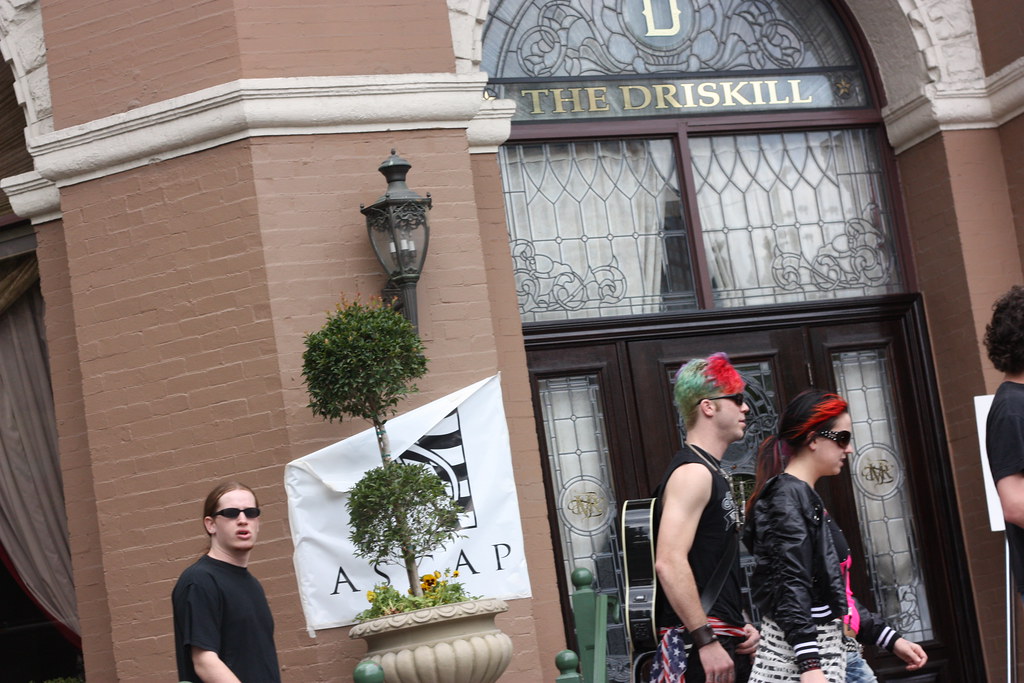
Posted by
wh
at
9:18 AM
0
comments
![]()
Upcoming Event: Asian Images @ Stanford, 5/10

Asian Images - performances and a panel discussion with spoken word artist Alvin Lau and the hiphop musicians of Magnetic North.
Sunday, May 10th at 8pm
Oak West Room, 2nd floor of Tresidder Union
Stanford University campus
459 LAGUNITA DR,
STANFORD, CA 94305
There is free parking in the large lot in front of the complex. The event is completely free of charge and open to everyone. For more information or directions, please feel free to contact Nguyen Pham (ntpham@stanford.edu) or Kelly Nguyen (knguyen3@stanford.edu).
link to the facebook group event:
http://www.facebook.com/event.
YellowBuzz is psyched to see APA music events popping up on campus. Music and Education rules!
Posted by
wh
at
8:52 AM
1 comments
![]()
Labels: upcoming events
5.05.2009
Video: The Pains of Being Pure at Heart Live Performance Video
This came through yesterday: A video of The Pains of Being Pure at Heart live at the Music Hall of Williamsburg in Brooklyn on 2/27/09. This is a hi-def video of TPBPH's performance of "Come Saturday." The entire 22-minute video can be screened from the baeblemusic site.
Posted by
wh
at
8:17 AM
0
comments
![]()
5.04.2009
Mapping the Digital Diaspora of YellowBuzz (a Dissertation Blog)
At the onset of my field research in summer 2007, I launched a blog – YellowBuzz.org – with the intention to: 1) archive and organize my field notes in textual and audio-visual form; 2) convey my research purpose and progress to informant musicians and the public; 3) self-position as a “participant” in the scene. Since then, I have made over 160 posts, some directly linked and others tangentially related to my research findings about the activities and media of Asian American indie rock musicians. Over the past one and a half years, my field research blog has received attention from both print and online media. Evidently, this blog has constructed a community consisting of musician- and music-enthusiast-visitors with an interest in Asian American and transpacific music-culture.
This past January, I began tracking the blog traffic by using Google Analytics. This service monitors the physical location of site visitors and their interactions with the pages on the site. The geographical data are analyzed in terms of the number of visits per unit of geographical organization such as city, country/territory, sub continent region, and continent. This information is also visualized in the form of an interactive map on which users can zoom in and out of specific locales and find site visit patterns specific to cities, countries, regions, or continents in the world.
Over the last four months, I have been playing with the May Overlay function projecting geospatial patterns of the site traffic on my blog. These interactive moments have helped me imagine interesting questions such as: What is the geography of an electronic community based on the topic of “Asian American music,” the tagline of my blog? What does the geo-spatial terrain of this “digital diaspora” look like? Are there any striking patterns at each of the organizational level namely, the city, country, sub-continental region, and continent? What spatial boundaries are transcended and created in these visualizations? Or, fancifully, how does the digital geography of my blog reconfigure the more general social geography of “Asian America” online or offline?
Today marks a 4-month anniversary of this thought experiment. I decided to take some screen shots of a few of the visualizations that I’ve found more meaningful in Google Analytics. This analysis uses data from a sample of 3,061 site visits collected from January 1 to April 30, 2009. I will highlight a few interesting findings below:
1) Here’s a map of blog visits in various U.S. cities. It appears that the visitors are concentrated in central Virginia (the home of yours truly), New York City, Boulder, Los Angeles, and San Francisco. Other than central Virginia and Boulder, these are areas of high concentration of Asian Americans and indie rock activities. I'm not quite sure how to explain the traffic flow from the Denver area (Boulder and Aurora, ranked third and sixth in this map, respectively) other than to link it to the thriving indie rock scene in Boulder and the physical location of an Asian/Japanese music blogger Shay of Sparkplugged.
2) According to this chart, 76% of the site visits have occurred within the boundaries of the United States. Next on the list are Canada, United Kingdom, and Australia, all English-speaking countries with close historical ties to American music. In the continent of Asia, countries such as Taiwan, South Korea, the Philippines, and Singapore have among the highest number of visitors to my site. I attribute this pattern to my blog posts about U.S.-based artists who have a large following in these particular countries. Specifically, Hsu-nami (of New Jersey) and Johnny Hi-Fi (SF-based) has strong ties to Taiwan; Kite Operations (New-York) to South Korea; Plus/Minus (New York) to the Philippines and Taiwan.
3) This last chart represents the sub-continental spread of the site visits. North America takes the lead (taking 80% of all visits). Northern Europe and Eastern Asia tie as second, followed by South-Eastern Asian and Western Europe. I’m not quite sure how to explain the high number of visits from Northern Europe other than to link it to the popularity of a Taiwanese metal band Chthonic in North Europe. Chthonic has a strong international presence, having worked with producers in Denmark and the U.S. including Rob Caggiano, the guitarist of Anthrax. In 2007, Chthonic toured with the OzzFest and established close ties with Taiwanese-American-led erhu rock group Hsu-nami.
So what does this all mean? YellowBuzz, a blog on “Asian American music”, has constructed a global, transnational readership. Asian America in the online digital environment exists beyond the boundaries of the United States and the Asian continent. These observations of transnational crossings work against the geography of Orientalism: a now-classical postcolonial theory referring to the representational control of the non-west by western-produced discourse. The transnational digital diaspora of YellowBuzz has tampered with the so-called east-west binary.
Now if I were serious about pursuing the research on the transnationality of Internet music journalism, I would look for a correlation between blog content and traffic patterns. This would require systematic, post-to-post observations. I would also consider mapping information regarding Internet access and user demographic with the intention to find links between the blog statistics and general Internet sociality. I would also look for statistical and mapping methods more powerful than Google Analytics.
But – to get back to my dissertation that asks: What paths do musicians and their music take as they establish routes crossing territories constructed by nation-states, corporations, international laws, etc? Unfortunately, these visualizations lack the analytical strength to provide an insight on the musicians’ perspective on the scene. They have offered a perspective on media, in particular in understanding the role of a music blog in constructing “Asian America.”
In the coming months, I will be working on a digital humanities project with Joe Gilbert at UVa’s Scholars’ Lab pursuing questions related to the musicians’ side of the story. I hope to unravel the terrain of musicians’ sociality within the transnational scene of indie rock music by mapping out their tours, social networks on (SNS), and record distribution. Meanwhile, I’m experiencing a bout of euphoria loving the fact that I have reclaimed a free market analytical tool offered by Google for my academic(-y) ethnomusicological thought experiment.
//////////////////
A version of this post has appeared on the UVa Scholars' Lab Blog.
Posted by
wh
at
6:38 AM
3
comments
![]()
Labels: diss ideas, general, internet, mapping, reflection, scholars lab, transnational
5.03.2009
May Day Parade Brought Together Richmond's Workers and Activists
I marched in a May Day Parade organized by my friend Kenneth Yates on last Friday, May 1. It took place in Jackson Ward, a historically black and working class neighborhood that has been rapidly gentrified by condo contractors and art gallery businesses in the recent few years. The march began at Abner Park and circled around four blocks and ended at Gallery 5 where Repressed IV, an exhibition featuring socially engaged posters and paintings, was showcased for the month of May. Individuals interested in raising awareness for a host of social issues such as workers' rights, gentrification, immigration rights, Food Not Bombs, bikes, sustainable living, etc united at this event.
I was holding a large banner with a friend that led the march. These are the shots I took before and after the parade. Enjoy them.


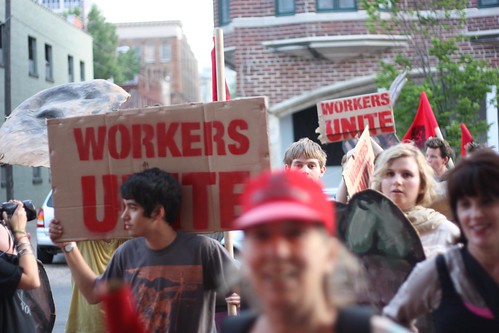


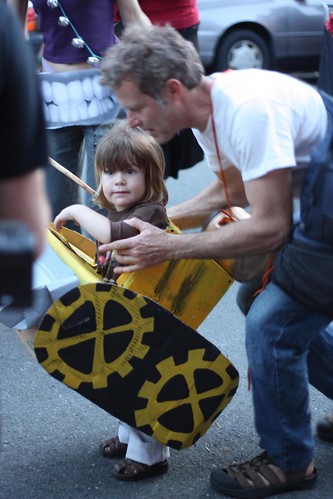
More pictures from my Flickr set. Here are two more sets of photos taken at the same event by Hassan Pitts and Jennida Chase.
The march was supported by the powerful No BS! brass band and the brilliant theatricality of All The Saints Theater Company, and sponsored by Virginia May Day Coalition, Lucent Phoenix Peoples Resource Center, Jobs With Justice, AFL-CIO, SEIU, Defenders For Freedom, Justice & Equality, and many other local activists.
Posted by
wh
at
3:42 PM
0
comments
![]()
Labels: action, current events, pictures
5.02.2009
Barry Barfield Rhymes to Challenge Racial Purity
Royal of Asian Rap Worldwide posted a video by spoken word artist Barry Barfield today. My curiosity led me to hit 'play', only to discover that this is one of the few pieces that I've encountered so far that address the issue of biraciality. In this video performance, Barfield talks about his existence of being between the racial categories of "white" and "Asian", the ethnic categories of "American" and "Korean". He struggles to locate a sense of belonging in one community or another but finds that neither group accepts him. Barfield rhymes, "I dream to be not in-between... I mean, can't I just be a person? Man, a student? Someone who lives the moment and tends to like prunes? A baseball lover? A fan of hip hop?" A bit taken aback by the sincerity of Barfield's words, I decided to post this video. Maybe the haunting and lyrical ambivalence created by the sample of "Vaka" by Sigur Ros got to pay serious attention to the words.
The issue of biraciality deserves almost urgent attention within the Asian American AND mainstream U.S. society. I learned from Tomie Hahn's stimulating text Sensational Knowledge that biracialty symoblizes miscegenation. Biraciality embodies the social fear and threat stemmed from the ideology of racial purity. I give Barfield props for speaking up against this unjust social condition.
Posted by
wh
at
7:00 PM
0
comments
![]()









